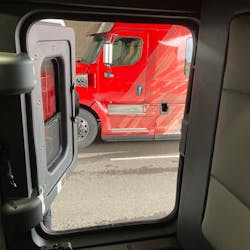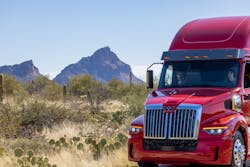Western Star’s 57X: Safety tech put to the test
YPSILANTI, Michigan—I’m no professional truck driver. Full transparency: I’ve only driven Class 8s in controlled environments—on test tracks, at industry events, and always with a chaperone (you’re welcome, everyone).
I typically find the whole experience of driving a fully equipped new truck exhilarating. Fun. Cool. Intimidating even. For me, getting behind the wheel of Western Star’s all-new 57X on-highway truck was less intimidating. First off, the truck itself is a stunner, and the interior of the all-new cab is luxurious, spacious, and features digital enhancements that you would see in a brand-new swanky car.
Western Star also didn’t skimp on creature comforts for this truck. For someone who blew out her back doing yard work just days before, the ergonomic driver’s seat was a welcome surprise. Sleeper models—the 60-inch mid-roof, 72-inch mid-roof, and 72-inch stratosphere—offer leather seating and an optional enhanced driver’s lounge with a table and Murphy bed. Side windows in the driver bunk and an improved HVAC system also make the cab feel just a little more like home.Aside from all the comforts, the most impressive features of the 57X are how easy it is to drive—especially for rookies—and how safe you feel operating a loaded tractor-trailer grossing 80,000 lbs.
See also: First look: Western Star’s all-new on-highway truck
The 12-speed DT12 automated transmission—direct or overdrive options—improves shifting and reduces wear and tear for both the driver and the vehicle. Low-speed maneuverability functions also help with steering to reduce fatigue (and body aches) in more urban environments.
Since this truck is geared toward owner-operators and linehaul fleets, there is an option to disable functionalities and customize according to preference. No worries there.
The other standout feature of this truck is that the 57X comes standard with the Detroit Assurance 5.0 safety system with Active Brake Assist 5, an always-on system that fuses camera and radar technology to detect moving obstacles in front of the truck and deploy full braking. I experienced this one firsthand and had an “oh, wow” moment. We’ll come back to this.
With Detroit Assurance also comes adaptive cruise control (ACC to 0 mph) and optional active lane assist, which includes lane-keep assist, auto stop, lane-departure protection, and steer assist. Additionally, the 57X debuts active side guard assist, designed to mitigate blind side issues during right-hand turns.
Safety tech in action
Vic Meloche, field sales engineering manager for Daimler Truck North America, took a fellow trade journalist and me out for a spin on a rainy morning in late July at the American Center for Mobility, just outside Detroit. He wanted to show us just how impactful some of these technologies are.
Before he did, though, Meloche made a point to note that it can take some veteran drivers a while to embrace these types of systems.
“Drivers don’t like when things do things they either don’t understand or they can’t anticipate,” Meloche said. “It’s all just getting a comfortable feeling of, ‘This is steering for me, but it’s not oversteering or understeering. I can learn to trust the system.’ When they do that, that’s when they stop fighting it.”
Meloche first showed us how the active sideguard assist functionality works. Essentially, a yellow triangle flashes when there is an object on the right-hand side of the vehicle. If the operator puts on the right turn signal and tries to steer into that lane, the triangle turns red, and the system sends off continuous cautionary beeps.
And at low speeds—roughly 12 mph or less—if there is a pedestrian or bicyclist on the right-hand side of the vehicle and the driver steers into that lane, the system will automatically put on the brakes and keep the driver from hitting that object. Worst case, if the vehicle does make contact, the hope is the truck would bump or gently knock down the pedestrian without pulling them under the tandems.
This is something I want in my car.
Now, for the auto stop feature and our “aha” moment.
As we take off in ACC at about 38 mph, Meloche takes his hands off the steering wheel and drives for about 15 seconds. After 15 seconds, a caution displays on the digital dash, telling him to put his hands back on the wheel. After 30 seconds, a red warning pops up and is accompanied by an audible beep every five seconds.
Then, the cadence ramps up to every second for five seconds, and after a minute, the display says, “going into auto stop.” The vehicle comes to a complete stop, puts on the hazards, and automatically deploys brake hold.
If the driver falls asleep or has become incapacitated for one minute, the system brings the vehicle to a complete stop.
“Oh, my goodness! This is going to save lives,” we (the two journalists) blurt out. Our minds are blown.
What are fleets saying?
Overall, when we ask about fleet reactions to Detroit Assurance and other types of safety systems, Meloche basically told us it all depends.
“The initial reaction, particularly if the safety manager is in the room, is, 'Yeah, that’s a good thing,'” he explained. “Then some other managers will start the what-if game—what if this, what if that? A lot about driver retention is, ‘How accurate are your speed limits? Am I just going to annoy drivers by doing things?’ It’s always that give and take between the safety manager and the fleet manager and the drivers who are there.”
Ultimately, Meloche said, it’s about educating the driver as to what these trucks are doing, why they are doing it, and why the fleet is adopting this technology to begin with.Even with those initial mixed reactions, these systems end up being a no-brainer for many fleet managers. Detroit Assurance is an option for the Freightliner Cascadia and Western Star brands.
“Once fleets started buying and testing it, they immediately flip over into standard,” Len Copeland, DTNA’s product marketing manager, told FleetOwner. “They shared the numbers on the reduction of collisions and the reduction in the losses and risk that is present in today’s environment. Detroit Assurance minimizes risk for them as fleets.”
Dialing that back to an owner-operator, Copeland added that business owners relying on one or few trucks as their income should be able to benefit from a safety system that is going to keep them safe and their business up and running.
“The Detroit Assurance system can be as customizable as drivers need it to be,” Copeland emphasized. “They can have the dash adjusted to turn off features, adjust them temporarily or for an extended period. However, fleet managers might not want drivers messing with the system and they want it on. So, they want the ability to block drivers from messing with it. It’s customizable at time of order and in service.”
About the Author

Cristina Commendatore
Cristina Commendatore is a past FleetOwner editor-in-chief. She wrote for the publication from 2015 to 2023.


